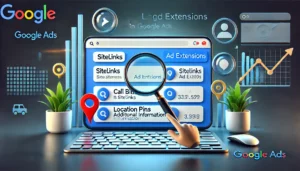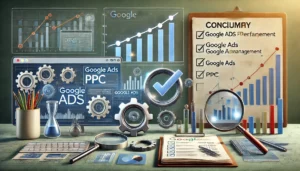Is Your Google Ads PPC Campaign Underperforming? Here’s Why

Google Ads PPC Management: Are your Google Ads PPC campaigns not delivering the results you expected?
Many businesses face challenges in making their PPC campaigns work effectively.
Understanding the common issues and knowing how to address them can turn things around.
This article will guide you through various aspects of Google Ads management to help you identify and fix problems, ensuring your campaigns perform at their best.
Key Takeaways for Google Ads PPC Management
- Identify and address common issues like low click-through rates, poor conversion rates, and high cost per acquisition.
- Evaluate and optimise your keyword strategy, including the use of negative and long-tail keywords.
- Improve your ad copy and creative elements by crafting compelling headlines and strong calls-to-action, and conducting A/B testing.
- Optimise your landing pages for better conversions by ensuring they are mobile-friendly and align with your ad content.
- Regularly monitor and adjust your campaign performance using tools like Google Analytics and set up performance alerts.
Identifying Common Issues in Google Ads PPC Management
Running a successful Google Ads PPC campaign can be challenging. We often encounter several common issues that can hinder performance. Let’s dive into some of these problems and how to address them.
Low Click-Through Rates and Their Causes
One of the most frequent issues is low click-through rates (CTR). A low CTR can be caused by irrelevant ad copy, poor keyword selection, or even the wrong audience targeting. Ensuring your ad copy is engaging and your keywords are relevant can significantly improve your CTR.
Poor Conversion Rates Despite High Clicks
Sometimes, we see campaigns with high click rates but poor conversion rates. This often indicates a problem with the landing page or the offer itself. It’s crucial to align your landing page content with your ad copy to provide a seamless user experience.
High Cost Per Acquisition (CPA)
High CPA is another common issue. This can result from inefficient bidding strategies or targeting too broad an audience. Regularly conducting a PPC audit can help identify areas where you can cut costs and improve efficiency.
By addressing these common issues, we can transform underperforming campaigns into successful ones. Remember, continuous monitoring and optimisation are key to a thriving PPC campaign.
Evaluating Your Keyword Strategy
Importance of Keyword Relevance
Choosing the right keywords is crucial for the success of your Google Ads campaign. We need to ensure that our keywords are highly relevant to our products or services. This relevance helps in attracting the right audience and improving our ad performance. Irrelevant keywords can waste our budget and lower our Quality Score.
Negative Keywords and Their Impact
Negative keywords are just as important as positive ones. They help us philtre out unwanted traffic that is unlikely to convert. By adding negative keywords, we can prevent our ads from showing up for irrelevant searches. This not only saves money but also improves our click-through rate (CTR) and conversion rates.
Long-Tail Keywords for Better Targeting
Long-tail keywords are longer and more specific keyword phrases. They may have lower search volumes, but they often attract more qualified traffic. Using long-tail keywords can help us target niche markets and improve our chances of conversion. They are especially useful for improving expected CTR and getting better results from our campaigns.
By focusing on the right keywords, we can significantly enhance the performance of our Google Ads campaigns. It’s all about finding the right balance between relevance, negative keywords, and long-tail keywords.
Improving Ad Copy and Creative
Crafting Compelling Headlines
Creating headlines that grab attention is crucial. We need to be direct and specific. Instead of saying, “We can help you find your way around social media,” try something like, “Social media management for your business, by our expert team.” This approach is more likely to attract clicks.
Using Strong Calls-to-Action
A strong call-to-action (CTA) can make a significant difference. Use action-oriented language and be clear about what you want the user to do. For example, “Sign up now for a free trial” is more compelling than “Learn more.” Highlight your unique selling propositions to make your CTA even more effective.
A/B Testing Ad Variations
A/B testing is essential for finding out what works best. Create two versions of your ad and test them against each other. This helps identify which elements are most effective and allows for continuous improvement. Regular updates and testing can prevent ad fatigue and keep your audience engaged.
Remember, great copy sells. By continuously refining our ad copy and creative, we can significantly improve our Google Ads performance.
Optimising Landing Pages for Better Conversions
Ensuring Mobile-Friendliness
We must not forget that a large number of users access the internet through their mobile devices. Therefore, it’s crucial to optimise our landing pages for mobile users. This means ensuring that the page loads quickly and is easy to navigate on smaller screens. A delay of even one second can significantly impact our conversion rates.
Creating Clear and Concise CTAs
A compelling Call-to-Action (CTA) is essential for driving conversions. Our CTAs should be the most prominent feature on the landing page, making it easy for visitors to take the desired action. We should avoid clutter and distractions that might divert users from the conversion goal. This includes removing irrelevant menus, sidebars, and images.
Aligning Landing Pages with Ad Content
It’s important to ensure that our landing pages are aligned with the content of our ads. When users click on an ad, they expect to find information that matches their search intent. If the landing page content is not relevant, users are likely to hit the back button, wasting our click budget. We should use targeted imagery and messaging to meet user expectations and establish credibility with social proof like testimonials or reviews.
Remember, the landing page is a strong indicator of our PPC campaign’s performance and has the potential to increase conversions exponentially.
Analysing Audience Targeting (Google Ads PPC management)
Understanding Your Audience Demographics
To get the best results from our Google Ads campaigns, we need to know who our audience is. By segmenting our data by age, gender, and income level, we can make targeted changes to our ads. For example, if younger audiences are engaging with our ads but not converting, it may indicate a need for different messaging or offers that resonate better with their preferences.
Utilising Audience Segmentation
Audience segmentation allows us to break down our audience into smaller groups based on specific criteria. This can include demographics, interests, behaviours, and location. By doing this, we can tailor our ads to better meet the needs of each segment. For instance, we can specify age groups, gender, household income, and even specific interests or behaviours that align with our product or service.
Retargeting Strategies for Improved Performance
Retargeting is a powerful strategy to bring back visitors who have previously interacted with our site but did not convert. By showing them relevant ads based on their past behaviour, we can encourage them to return and complete a desired action. This can significantly improve our conversion rates and overall campaign performance.
Pro Tip: Use negative keywords to exclude irrelevant searches and prevent wasted clicks. Continuously refine your keyword list based on performance data.
By understanding our audience and using segmentation and retargeting strategies, we can optimise our Google Ads campaigns for better performance.
Adjusting Bidding Strategies
Choosing the Right Bidding Model
Selecting the appropriate bidding model is crucial for the success of your Google Ads campaign. We have several options to choose from, including manual bidding, automated bidding, and conversion-based bidding. Manual bidding gives us full control over our bids, allowing us to set maximum bid limits for clicks or conversions. On the other hand, automated bidding uses machine-learning algorithms to adjust bids automatically based on factors like historical data, user behaviour, and conversion likelihood. Conversion-based bidding focuses on maximising conversions by automatically setting bids to achieve the highest possible conversion volume within our specified budget.
Setting Bid Adjustments Based on Performance
To optimise our ad performance, we need to regularly monitor and analyse the performance of our bidding strategies. Adjusting our bids based on factors such as keyword performance, ad position, and conversion rates is essential. Continuously testing and optimising our bidding approach will help us identify the most effective strategy for our specific campaign goals. It’s important to make small, incremental changes and allow a 7-day gap before making further adjustments. This prevents our campaign from going back into ‘learning mode’ and ensures consistent performance.
Automated Bidding vs Manual Bidding
Both automated and manual bidding have their pros and cons. Automated bidding can save us time and effort by using machine learning to optimise bids. However, it requires accurate conversion tracking and sufficient data to be effective. Manual bidding, while more time-consuming, gives us complete control over our bids and can be more effective if we don’t have enough data for automated bidding to work well. We should choose the bidding strategy that best aligns with our campaign goals and the data we have available.
Effective bidding strategies are essential for optimising ad performance and achieving a positive ROI. By carefully selecting and adjusting our bidding models, we can ensure our Google Ads campaigns perform at their best.
Monitoring and Adjusting Campaign Performance
Using Google Analytics for Insights
We can’t stress enough the importance of Google Analytics. It provides in-depth insights into user behaviour and conversion paths. By understanding these patterns, we can refine our targeting and improve overall campaign performance. Regularly checking metrics like bounce rate, session duration, and conversion rate helps us identify areas needing improvement.
Setting Up Performance Alerts
Setting up performance alerts is a proactive way to stay on top of your campaigns. These alerts notify us of any significant changes in key metrics, allowing us to act quickly. For instance, if there’s a sudden drop in click-through rates, we can investigate and address the issue promptly.
Regularly Reviewing Campaign Metrics
Google Ads PPC Management: Consistent review of campaign metrics is crucial. We should look at data segmented by demographics, devices, and time periods. This helps us understand which segments are performing well and which need adjustments. For example, if mobile users are not converting as expected, we might need to optimise our ads for mobile devices.
Regular monitoring and adjustments ensure our campaigns remain effective and aligned with our goals. By staying vigilant, we can adapt to changes and continuously improve our performance.
Using Google Analytics for Insights
We can’t stress enough the importance of Google Analytics. It provides in-depth insights into user behaviour and conversion paths. By understanding these patterns, we can refine our targeting and improve overall campaign performance. Regularly checking metrics like bounce rate, session duration, and conversion rate helps us identify areas needing improvement.
Setting Up Performance Alerts
Setting up performance alerts is a proactive way to stay on top of your campaigns. These alerts notify us of any significant changes in key metrics, allowing us to act quickly. For instance, if there’s a sudden drop in click-through rates, we can investigate and address the issue promptly.
Regularly Reviewing Campaign Metrics
Consistent review of campaign metrics is crucial. We should look at data segmented by demographics, devices, and time periods. This helps us understand which segments are performing well and which need adjustments. For example, if mobile users are not converting as expected, we might need to optimise our ads for mobile devices.
Regular monitoring and adjustments ensure our campaigns remain effective and aligned with our goals. By staying vigilant, we can adapt to changes and continuously improve our performance.
Leveraging Ad Extensions
Ad extensions are a powerful way to enhance your Google Ads campaigns. They provide extra information about your business, making your ads more appealing and useful to potential customers. Let’s explore the different types of ad extensions and their benefits.
Understanding Quality Score and Its Impact
Factors Influencing Quality Score
Quality Score is a crucial metric in Google Ads that affects both ad positioning and costs. It is determined by three main factors:
- Click-Through Rate (CTR): A higher CTR indicates that users find your ad relevant.
- Ad Relevance: Ensuring your ad copy matches the keywords and user intent.
- Landing Page Experience: The landing page should be user-friendly and relevant to the ad.
Improving Ad Relevance and Landing Page Experience
To boost your Quality Score, focus on making your ads more relevant and enhancing the landing page experience. Here are some tips:
- Relevant Keywords: Use keywords that closely match user search queries.
- Optimised Ad Copy: Write clear and compelling ad copy that addresses user needs.
- Landing Page Quality: Ensure your landing page is fast, mobile-friendly, and provides valuable content.
Improving these elements not only enhances your Quality Score but also drives better overall campaign performance.
Monitoring Quality Score Changes
Regularly monitoring your Quality Score is essential for maintaining and improving your campaign’s performance. Use Google Ads tools to track changes and identify areas for improvement. By keeping an eye on these metrics, we can make informed decisions to optimise our campaigns effectively.
Utilising Advanced Google Ads Features
Exploring Smart Campaigns
Smart Campaigns are designed to simplify the advertising process for small businesses. They use machine learning to automate ad creation and targeting, making it easier for us to reach potential customers. By leveraging Smart Campaigns, we can save time and focus on other aspects of our business.
Using Dynamic Search Ads
Dynamic Search Ads (DSAs) automatically generate ads based on the content of our website. This feature is particularly useful for businesses with a large inventory of products or services. DSAs help us capture relevant search queries that we might have missed with traditional keyword targeting.
Implementing Responsive Search Ads
Responsive Search Ads (RSAs) allow us to create multiple headlines and descriptions, which Google then tests to find the best-performing combinations. This flexibility ensures that our ads are always optimised for maximum performance. Using RSAs can significantly improve our ad relevance and click-through rates.
Embracing these advanced features can transform our Google Ads campaigns, making them more efficient and effective. Let’s take advantage of these tools to stay ahead in the competitive digital landscape.
Addressing External Factors Affecting Performance
Seasonal Trends and Their Impact
Seasonal trends can significantly influence your PPC campaign performance. For instance, swimwear ads will naturally see a surge in summer but may dip in winter. Recognising these patterns helps us adjust our campaigns accordingly. Understanding these trends allows us to optimise our budget and bids to match the expected demand.
Competitor Activity and Market Changes
The PPC landscape is highly competitive and ever-changing. New competitors entering the market or existing ones ramping up their efforts can impact your campaign’s performance. We need to keep an eye on our competitors’ activities and adjust our strategies to stay ahead. Tools like Spyfu and Auction Insights can provide valuable data on competitor behaviour.
Economic Factors Influencing Ad Performance
Economic conditions can also affect user behaviour and, consequently, your PPC campaigns. During economic downturns, consumers may be less likely to spend, impacting conversion rates. On the other hand, a booming economy can lead to increased competition and higher costs per click. By staying informed about economic trends, we can make better decisions about our PPC strategies.
Sometimes, external factors, beyond your campaign strategies, can influence your PPC performance. Recognising these factors and adjusting your approach is crucial for maintaining a successful campaign.
External factors can greatly impact your performance, but you don’t have to face them alone. Our team of experts is here to help you navigate these challenges and improve your results. Visit our PPC audit page to learn more about how we can support you.
Conclusion for Google Ads PPC management
Google Ads PPC management: In summary, if your Google Ads PPC campaign isn’t delivering the results you hoped for, don’t lose heart. There are many factors that could be affecting its performance, from keyword choices to ad copy and landing page quality. By carefully analysing these elements and making the necessary adjustments, you can turn things around. Remember, successful PPC campaigns require ongoing monitoring and tweaking. Keep testing different strategies, learn from the data, and don’t hesitate to seek expert advice if needed. With persistence and the right approach, you can achieve the desired outcomes from your Google Ads campaigns.
Google Ads PPC Management Frequently Asked Questions
Why is my Google Ads campaign not getting many clicks?
Your campaign might have low click-through rates due to irrelevant keywords, unattractive ad copy, or poor targeting. Make sure your ads are appealing and relevant to your audience.
What should I do if my ads get clicks but no conversions?
If you’re getting clicks but no conversions, your landing page might not be effective. Ensure it matches the ad content and has a clear call-to-action. Also, check for any technical issues.
How can I lower my Cost Per Acquisition (CPA)?
To lower your CPA, focus on improving your Quality Score by making your ads and landing pages more relevant. Also, refine your targeting and use negative keywords to avoid irrelevant clicks.
What are negative keywords and why are they important?
Negative keywords prevent your ads from showing up for unrelated searches. This helps you avoid wasting money on clicks that won’t convert, improving your overall campaign performance.
How can I improve my ad copy?
Craft compelling headlines, use strong calls-to-action, and highlight your unique selling points. A/B testing different versions of your ads can also help you find what works best.
Why is my Quality Score important?
Quality Score affects your ad’s position and cost-per-click. A higher Quality Score means your ads are more relevant, which can lead to better ad placements and lower costs.
What are long-tail keywords and how can they help my campaign?
Long-tail keywords are longer, more specific phrases that typically have lower competition. They can help you target a more specific audience, often leading to higher conversion rates.
How often should I review my Google Ads campaign performance?
Regularly review your campaign metrics, at least once a week. Use tools like Google Analytics to gain insights and make adjustments as needed to improve performance.
Author
Search Blog
Free PPC Audit
Subscribe to our Newsletter
The Voices of Our Success: Your Words, Our Pride
Don't just take our word for it. With over 100+ five-star reviews, we let our work-and our satisfied clients-speak for us.
"We have been working with PPC Geeks for around 6 months and have found Mark and the team to be very impressive. Having worked with a few companies in this and similar sectors, I rate PPC Geeks as the strongest I have come across. They have taken time to understand our business, our market and competitors and supported us to devise a strategy to generate business. I value the expertise Mark and his team provide and trust them to make the best recommendations for the long-term."
~ Just Go, Alasdair Anderson





